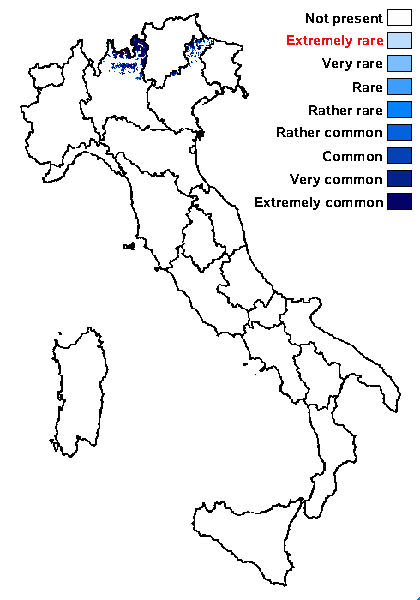Lecidea atrobrunnea (DC.) Schaer. subsp. stictica Hertel & Leuckert
in Nash & al., Lichen Flora Gr. Sonoran Desert Reg., 2: 297, 2004.
Synonyms:
Distribution: N - Ven (Hertel & Schuhwerk 2010), Lomb (Hertel & Leuckert 2008).
Description: Thallus crustose, episubstratic, 0.5-2.5 mm thick, areolate to almost squamulose, of flat to strongly convex, up to 3 mm wide, pale brown to dark browm (in central parts), often shiny areoles with a thin, whitish to blackish edge; prothallus absent or usually conspicuous, dark. Medulla white, I+ intensely blue-violet, Apothecia lecideine, black, 0.7-1.7(-2.5) mm across, often clustered, slightly constricted base, with a flat to convex, rarely bluish-pruinose disc, and a persistent, raised, often slightly wavy proper margin. Proper exciple of parallel-radiating, 3-7 µm thick hyphae, blue- to green-black in outer part, colourless or very pale brown within, 25-150 µm wide laterally; epithecium bright green, bluish-green, or olive-green; hymenium colourless to very pale greenish in upper part, 40-60 µm high, I+ blue; paraphyses coherent, usually simple or shortly branched in upper part, rarely anastomosing, 1.5-2.5 µm thick at mid-level, the apical cells clavate, 3-5 µm wide; hypothecium colourless to pale brown, I+ blue. Asci 8-spored, narrowly clavate, thick-walled, with a K/I+ pale blue tholus and a strongly amyloid, thin apical cushion, surrounded by a I+ blue outer layer, Lecidea-type. Ascospores 1-celled, hyaline, ellipsoid-oblong, with rounded ends, 7-11.5 x 3-5 µm. Pycnidia immersed with a usually irregular to graphidioid ostiolar region. Conidia bacilliform, (8.5-)11-17(-21) x 0.8-1.4 µm. Photobiont chlorococcoid. Spot tests: medulla K+ yellow, C-, KC-, P+ yellow-orange. Chemistry: stictic acid syndrome, with stictic acid (rarely hypostictic acid) as the major substance.Note: a holarctic silicicolous taxon with optimum near and above treeline; widespread but rarely collected in the Alps.
Growth form: Crustose
Substrata: rocks
Photobiont: green algae other than Trentepohlia
Reproductive strategy: mainly sexual
Species of metal-rich rocks
Commonnes-rarity: (info)
Alpine belt: extremely common
Subalpine belt: rather common
Oromediterranean belt: very rare
Montane belt: absent
Submediterranean belt: absent
Padanian area: absent
Humid submediterranean belt: absent
Humid mediterranean belt: absent
Dry mediterranean belt: absent

Predictive model
Growth form: Crustose
Substrata: rocks
Photobiont: green algae other than Trentepohlia
Reproductive strategy: mainly sexual
Species of metal-rich rocks
Commonnes-rarity: (info)
Alpine belt: extremely common
Subalpine belt: rather common
Oromediterranean belt: very rare
Montane belt: absent
Submediterranean belt: absent
Padanian area: absent
Humid submediterranean belt: absent
Humid mediterranean belt: absent
Dry mediterranean belt: absent

Predictive model
 Index Fungorum
Index Fungorum
 GBIF
GBIF

